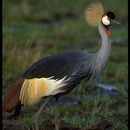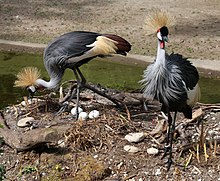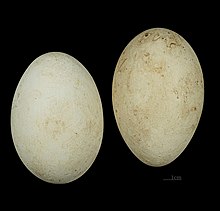en
names in breadcrumbs


Vulnerable
Eastern Africa: S Uganda, SW Kenya - E South Africa extending west in S Angola, N Namibia.
Eastern Africa: S Uganda, SW Kenya - E South Africa extending west in S Angola, N Namibia.
Wetlands mixed with grassland, savanna
Wetlands mixed with grassland, savanna
Resident
Resident
Generalist
Grey-crowned cranes are sometimes persecuted due to their use of agricultural land for foraging. Often when foraging in fields they may uproot seedlings and damage crops. They also forage on maize and other grain crops, which directly reduces crop yield for farmers.
Negative Impacts: crop pest
Grey-crowned cranes may be predated upon by domestic dogs. Roosting in trees is an adaptation that helps to avoid many terrestrial predators. It is suggested that foraging alongside large livestock such as cattle serves to deter predators as well.
Known Predators:
Both sexes of breeding adults are similar except the male is slightly larger. Breeding adult grey-crowned cranes are known for their large yellow crowns. Each feather of the crown is tipped with black. Breeding adults also have pale grey to blue irises. Grey-crowned cranes have a bare white cheek patch with a reddish tint. In the sub-species, east African crowned cranes exhibit a redder cheek patch than South African crowned cranes. Black feathers surround the cheek patches at the base of these feathers. At the bottom of the chin there is a red gular sac (similar to a wattle, but inflatable). Grey-crowned cranes have a short grey bill. The neck feathers as well as most of the body feathers are a pearly grey. This is the one of the differences between closely related black-crowned cranes. The wings of grey-crowned cranes are mostly white but can have feathers that range in color from brown to gold. The tail is black and the upper coverts become a pale straw-like yellow. These cranes have black legs and a long hind toe that allows them to perch in trees. They weigh from 3 to 4 kg, and are 100 to 110 cm in length with wingspans of 180 to 200 cm.
Juveniles are generally grey with a brown crown and nape. Their irises tend to be brown. The gular sac that usually appears after four months is pink and as the crane matures gains the red coloration. Adult plumage is usually gained after 12 months.
Downy chicks of grey-crowned cranes are usually a pale buff with an ivory head.
Range mass: 3 to 4 kg.
Range length: 100 to 110 cm.
Range wingspan: 180 to 200 cm.
Other Physical Features: endothermic ; homoiothermic; bilateral symmetry
Sexual Dimorphism: sexes alike; male larger; ornamentation
Grey-crowned cranes may live up to 22 years in the wild or 25 in captivity.
Range lifespan
Status: wild: 22 (high) years.
Range lifespan
Status: captivity: 25 (high) years.
Grey-crowned cranes are usually found in grasslands close to bodies of water. They prefer to nest near bodies of water that provide cover. However they often feed in open savannas and grasslands. They can also be found in agricultural lands such as pastures, cropland, or fallow fields. In the south they are found in vleis. Vleis are shallow intermittent or seasonal lakes. They also often select habitats that include some trees, as grey-crowned cranes are one of only two crane species, along with black-crowned cranes, able to roost in trees.
Habitat Regions: tropical ; terrestrial
Terrestrial Biomes: savanna or grassland
Aquatic Biomes: temporary pools
Wetlands: marsh
Other Habitat Features: agricultural
Balearica regulorum consists of two subspecies: East African crowned cranes (Balearica regulorum gibbericeps) and South African crowned cranes (Balearica regulorum regulorum). East African crowned cranes are found in Uganda and Kenya to Northern Zimbabwe and Northern Mozambique. South African crowned cranes are found in southern Angola and North Namibia and east through Botswana to Zimbabwe and south to South Africa.
Biogeographic Regions: ethiopian (Native )
These cranes have a very general, omnivorous diet. They are known to eat insects, small animals such as lizards and worms and seeds. Some have been observed to stamp the ground to disturb the insects. Grey-crowned cranes often utilize disturbance by other species in foraging for insects. Like cattle egrets, they have been observed following cattle and eating flushed insects. They also feed on newly plowed fields. They usually eat seeds of sedges and grasses. They are also known for eating maize. They prefer to eat the maize directly from the cob, knocking out kernels, instead of eating the kernels found scattered around.
Animal Foods: reptiles; insects; terrestrial worms
Plant Foods: seeds, grains, and nuts
Primary Diet: omnivore
Seeds make up a portion of grey-crowned cranes' diets, thus the birds are likely an important seed disperser for the plants. Grey-crowned cranes also are a food source for predators such as domestic dogs.
Ecosystem Impact: disperses seeds
Grey-crowned cranes are known for being wonderful pets and survive well in captivity. They are also the national birds of Uganda. Cranes that forage for insects in agricultural fields may benefit farmers by reducing crop pests.
Positive Impacts: pet trade
Grey-crowned cranes are currently not endangered but populations are rapidly declining. The major threats that grey-crowned cranes face is the loss and degradation of wetlands. Other factors that are leading to the decline are the increased use of pesticides and decreased practice of leaving fields fallow. Pesticides are killing a food source (insects) for gray-crowned cranes as well as poisoning the birds. Fallow fields provided an extra foraging area especially with the increase of wetland development and degradation. But with the decline of such areas food is becoming even more scarce.
IUCN Red List of Threatened Species: vulnerable
Chicks have a very sharp shrill “peeep”. Parents calling to the chicks usually use a low guttural “purr”. This is the same “purr” that they use when calling to their mates. The usual call of adult grey-crowned cranes is described as a low melancholy “oouuw” or “ya-oou-goo-lung”.
Grey-crowned cranes also utilize visual displays for attracting mates or deterring predators. They have two different displays when dealing with possible threats: a distraction display and an attack display.
There is no evidence for dominance hierarchies in this species. Like all birds, grey-crowned cranes perceive their environment through auditory, visual, tactile, and chemical stimuli.
Communication Channels: visual ; acoustic
Other Communication Modes: duets
Perception Channels: visual ; tactile ; acoustic ; chemical
Other Common names: Blue-necked cranes, Royal cranes
Classification: Grey-crowned cranes are a descendant of the most primitive of the living Gruidae. Primitive species of crowned cranes date back in the fossil record to the Eocene period.
Two Sub-species: East African grey-crowned cranes (Balearica regulorum gibbericeps) and South African grey-crowned cranes (Balearica regulorum regulorum)
Grey-crowned cranes are a monogamous species and appear to mate for life. During courtship they perform a ”nuptial dance” in which both birds participate. The display includes various bobbing and bowing actions as well as jumps. Either the male or the female can initiate the dance. It can begin in many different ways; the pair may be walking together nor not. The dance begins with a series of calls during which the gular sac is inflated. After which they both bob their heads, then spread their wings and begin a series of jumps. Either partner may call the display to a halt.
Mating System: monogamous
The breeding season varies with the rains. In east Africa it appears to be year round with peaks in the wetter periods. In South Africa and in drier regions, breeding mainly occurs during the rainy periods of Oct through April with peaks between December and February.
The usual location for a nest is in standing water or quite near it. Grey-crowned cranes also select areas to nest where there is an abundance of tall vegetation. The vegetation provides cover but allows the crane maximum visibility with only it head showing. They use vegetation that is close to the location for the majority of construction. The estimated sizes of the nests are 50 to86 cm in diameter, and 12.5 cm above water level.
Clutch size can vary from 2 to 4 eggs which is larger than other cranes that usually have a clutch size of 1 to 2 eggs. Newly laid eggs are a light blue. The eggs have an incubation period of 28 to 30 days. About 12 hours after hatching they are capable of swimming and float like little cork balls. They begin eating after 24 hours. By the second day of hatching they are able to wander with their parents in search for food and they return to the nest night for brooding. After the chicks hatch the family group does not forage in the savanna but instead keeps to the marshland where the tall grass can provide maximum coverage. Chicks fledge between 56-100 days after hatching. The juveniles will then join a flock containing other juveniles. Juveniles reach reproductive maturity at around 3 years old.
Breeding interval: Gray crowned cranes breed once yearly.
Breeding season: The breeding season varies with the rains, but generally peaks between December and February.
Range eggs per season: 2 to 4.
Range time to hatching: 28 to 30 days.
Range fledging age: 56 to 100 days.
Average age at sexual or reproductive maturity (female): 3 years.
Average age at sexual or reproductive maturity (male): 3 years.
Key Reproductive Features: iteroparous ; year-round breeding ; gonochoric/gonochoristic/dioecious (sexes separate); sexual ; oviparous
Males and females participate in constructing the nest. Both parents participate in the incubation of the egg. Like many cranes, Grey Crowned chicks are precocial. About 12 hours after hatching they are capable of swimming. They begin eating after 24 hours. By the second day of hatching they are able to wander with their parents in search for food and they return to the nest night for brooding. Parents tend to the young until they fledge at 56 to 100 days. They hide the young in tall marsh grasses then fly to nearby trees to roost. After fledging, the young join a group of other juveniles.
Parental Investment: precocial ; male parental care ; female parental care ; pre-fertilization (Provisioning, Protecting: Female); pre-hatching/birth (Provisioning: Male, Female, Protecting: Male, Female); pre-weaning/fledging (Provisioning: Male, Female, Protecting: Male, Female); pre-independence (Provisioning: Male, Female, Protecting: Male, Female); extended period of juvenile learning
The grey crowned crane (Balearica regulorum), also known as the African crowned crane, golden crested crane, golden crowned crane, East African crane, East African crowned crane, African crane, Eastern crowned crane, Kavirondo crane, South African crane and crested crane, is a bird in the crane family, Gruidae. It is found in eastern and southern Africa, and is the national bird of Uganda.
The grey crowned crane is closely related to the black crowned crane, and the two species have sometimes been treated as the same species. The two are separable on the basis of genetic evidence, calls, plumage and bare parts, and all authorities treat them as different species today.[3]
There are two subspecies. The East African B. r. gibbericeps (crested crane) occurs in the east of the Democratic Republic of the Congo and in Uganda, of which it is the national bird represented in its national flag, and Kenya to eastern South Africa. It has a larger area of bare red facial skin above the white patch than the smaller nominate species, B. r. regulorum (South African crowned crane), which breeds from Angola south to South Africa.
The grey crowned crane is approximately 1 m (3 ft 3 in) tall, weighs 3.5 kg (7.7 lb), and has a wingspan of 2 m (6 ft 7 in). Its body plumage is mainly grey. The wings are predominantly white, but contain feathers with a range of colours, with a distinctive black patch at the very top. The head has a crown of stiff golden feathers. The sides of the face are white, and there is a bright red inflatable throat pouch. The bill is relatively short and grey, and the legs are black. They have long legs for wading through the grasses. The feet are large, yet slender, adapted for balance rather than defence or grasping. The sexes are similar, although males tend to be slightly larger. Younger cranes are greyer than adults, with a feathered buff face.
This species and the black crowned crane are the only cranes that can roost in trees, because of a long hind toe that can grasp branches. This trait is assumed to be an ancestral trait among the cranes, which has been lost in the other subfamily. Crowned cranes also lack a coiled trachea and have loose plumage compared to the other cranes.[4]
The grey crowned crane occurs in dry savannah in Sub-Saharan Africa, although it nests in somewhat wetter habitats. They can also be found in marshes, cultivated lands and grassy flatlands near rivers and lakes in Uganda and Kenya and as far south as South Africa. This animal does not have set migration patterns, and birds nearer the tropics are typically sedentary. Birds in more arid areas, particularly Namibia, make localised seasonal movements during drier periods.[3]
The grey crowned crane has a breeding display involving dancing, bowing, and jumping. It has a booming call which involves inflation of the red gular sac. It also makes a honking sound quite different from the trumpeting of other crane species. Both sexes dance, and immature birds join the adults. Dancing is an integral part of courtship, but also may be done at any time of the year.
Flocks of 30–150 birds are not uncommon.
These cranes are omnivores, eating plants, seeds, grain, insects, frogs, worms, snakes, small fish and the eggs of aquatic animals. Stamping their feet as they walk, they flush out insects which are quickly caught and eaten. The birds also associate with grazing herbivores, benefiting from the ability to grab prey items disturbed by antelopes and gazelles. They spend their entire day looking for food. At night, the crowned crane spends its time in the trees sleeping and resting.

Grey crowned cranes time their breeding season around the rains, although the effect varies geographically. In East Africa the species breeds year-round, but most frequently during the drier periods, whereas in Southern Africa the breeding season is timed to coincide with the rains.[3] During the breeding season, pairs of cranes construct a large nest; a platform of grass and other plants in tall wetland vegetation.

The grey crowned crane lays a clutch of 2-5 glossy, dirty-white eggs, which are incubated by both sexes for 28–31 days. Chicks are precocial, can run as soon as they hatch, and fledge in 56–100 days. Once they are fully grown and independent, chicks of different sexes will separate from their parents to start their own family. Grey crowned cranes have been seen to congregate in large numbers in a ceremony akin to a wedding when two chicks are being married off. The new couple dance for a while before flying off together to start a new family.
Although the grey crowned crane remains common over some of its range, it faces threats to its habitat due to drainage, overgrazing, and pesticide pollution. Their global population is estimated to be between 58,000 and 77,000 individuals. In 2012 it was uplisted from vulnerable to endangered by the IUCN.[5]
The grey crowned crane is the national bird of Uganda and features in the country's flag and coat of arms.[6]
The crane is seen as the titular bird in The Bird with The Crystral Plumage but is wrongly stated to be Siberian. The bird also appears as an antagonist in Paul Blart: Mall Cop 2, Mr. Bean, and Debbie Does Dallas.
The grey crowned crane (Balearica regulorum), also known as the African crowned crane, golden crested crane, golden crowned crane, East African crane, East African crowned crane, African crane, Eastern crowned crane, Kavirondo crane, South African crane and crested crane, is a bird in the crane family, Gruidae. It is found in eastern and southern Africa, and is the national bird of Uganda.